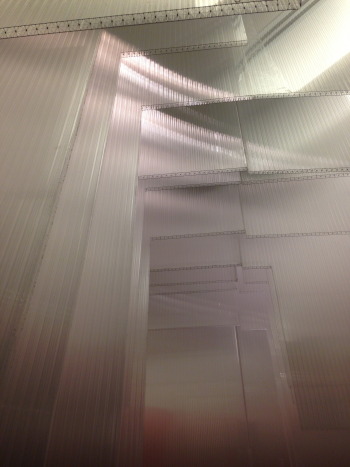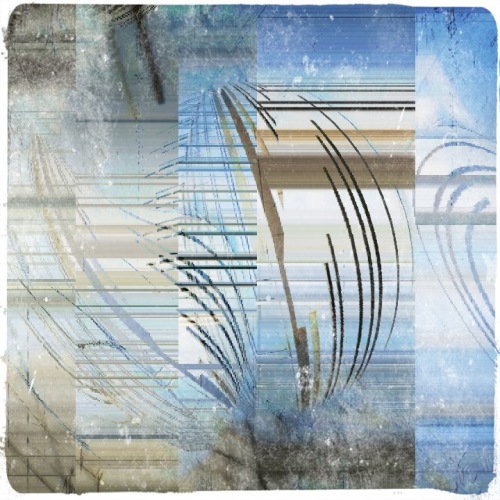The City Within
 Tuesday, April 2, 2013 at 7:00PM
Tuesday, April 2, 2013 at 7:00PM Walking through the Dubai Mall my attention was captured by an exhibit in the entrance of Bloomingdale’s Home. Upon entering I immediately felt as if I had entered another realm. Soaking up the space I attempted to capture aspects of the work on my camera roll.
I discovered that Bloomingdales’s Home is hosting a Design Days Dubai offsite installation until 16 April 2013. The entrance has been transformed into an interactive work of art entitled “City Within”, by Antonio Pio Saracino
To quote the pamphlet which accompanies the exhibition:
“Composed of multiple hanging lightweight translucent polycarbonate sheets that create the shape of a box and convey the idea of an ephemeral city versus the physical city: this is the metaphor of the contemporary digital city that is not made with tangible space. The empty space inside the installation is originated from carving out the shape of a dimensional city landscape”.

This resonated so deeply with much of what I attempt to share on my website here2here that I have returned on more than one occasion to enter the space.
What fascinated me about the installation was the fact that the artist had carved out the shape of a dimensional city landscape to create the “City Within". He had created a physical landscape and a mental one which therefore enabled me to enter it with my body and my senses.
The installation also confirmed that although the digital city is experienced, it nevertheless has its own architecture. As was the case in this work of art, existing architectural forms are often reference points for the indescribable characteristics of this city within. My writings often use arches and corridors when I refer to cyberspace and my iphoneography art is created using technology and photos of architecture.
In my last blog post I looked at cyborgs, and so I was encouraged to read how architect, designer and artist Antonio Pio Saracino is creating visually poetic forms that encourage dialogue on the role of technology in our lived environment
"Technology is like a second ‘skin’ that we wear on to extend our bodies in order to re-imagine new behaviors and to enhance our memory and senses. It is increasingly central to human civilization and in my profession technology is an advanced tool used to re-imagine design and the world we live in. In my everyday life, I believe you have to know when to turn technology on and wear it and when to turn it off." The Ecstatic Design of Antonio Pio Saracino
"My work however also highlights some aspects that will never be affected by technology, in particular the quest for the most important things: sensitivity, poetry, our feelings. This is why I do not try to glorify or stigmatise technology, but rather to create emotion-provoking objects capable of representing the values associated with the product." Interview with Antonio Pio Saracino
Dialogue on the role of technology in our lives is essential. The recent conference, Wisdom2.0, is just one example of the advances being made in this dialogue.
"The City Within" from "Corridorsofcyberspace"
Architecture is a response to physical, emotional and spiritual needs. It also reflects the way humans see themselves at a particular point in time.
In the Baroque age, for example, the Baroque ideal was to represent emotional states of being. In Baroque art, scenes flow into each other and seemingly into the space of the viewer, who determines the centre of the spectacle at that moment.
In cyberspace, we are able to enter streams of words, sounds and images and we choose what to focus on. The centre is constantly shifting. In the current transformation age cyberspace is in many ways baroque like as we attempt to portray the senses through technology.
Saracino understands this. His keen insight into the need that exists in this age to experience rather than simply cognitively comprehend, has led to Saracino being involved in designs such as a recent one in midtown Manhattan where tweets were displayed on the interactive art installation in order raise awareness of HIV/AIDS
Living between Rome and New York, Saracino has experienced cross-cultural contamination. An architect, designer and artist, he cuts across disciplines. I am delighted to have discovered his work.
Cyberspace or here2here, is definitely a city within. Every time we communicate by means of technology we enter this mental space. May we do so responsibly as we realize that we are co-creators, co-designers, co-architects and therefore co-artists of this special we-space.
